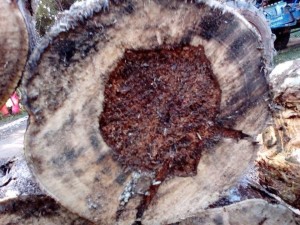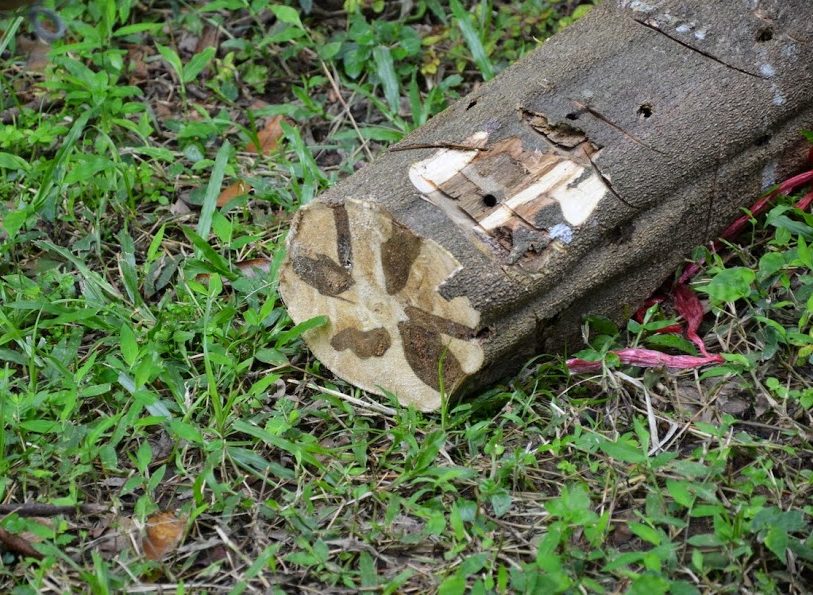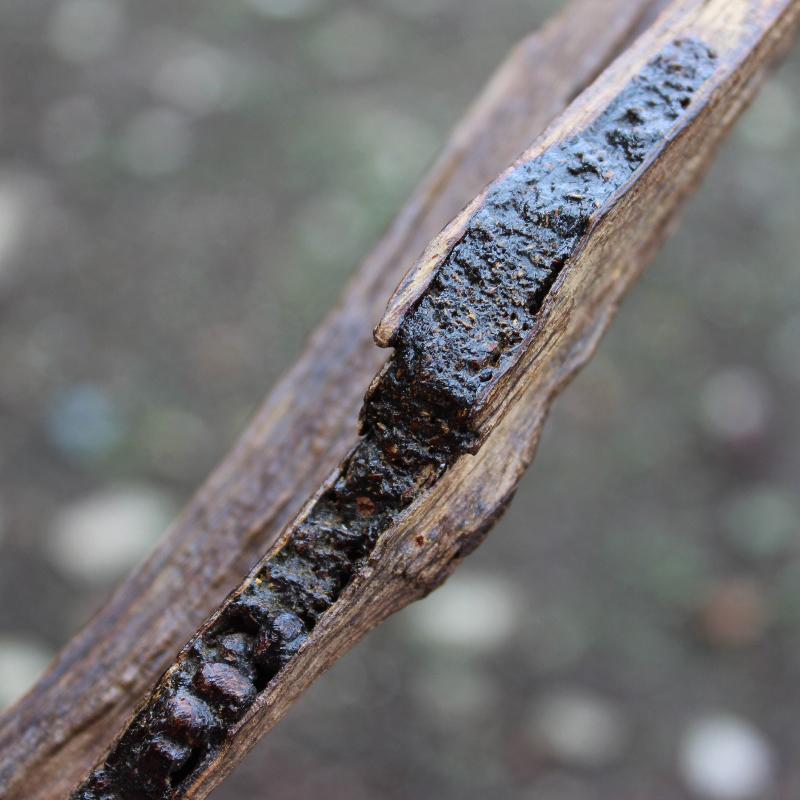

Agarwood or Gaharu as it is known in many Asian countries is a resinous heartwood that sometimes occurs in trees belonging to the genus Aquilaria (Thymelaeceae family). Aquilaria is a fast-growing, archaic subtropical forest tree, with a population range stretching from South Asia’s Himalayan foothills, throughout Southeast Asia, and into the rainforests of Papua New Guinea. It grows at elevations from a few meters above sea level to about 1000 meters, with approx. 500 meters being most ideal. Aquilaria can grow on a wide range of soils, including poor sandy soil. Seedlings require a great deal of shade and water but will grow rapidly, producing flowers and seeds as early as four years old. At least fifteen species of Aquilaria are known to produce the much sought-after agarwood. In South Asia, particularly India, Aquilaria achalloga is found. Aquilaria malaccensis is mostly known from Malaysia and Indonesia, while Aquilaria crassna grows primarily in Indochina. A number of others are also known, such as Aquilaria grand folio, Aquilaria Chinese etc., though these are relatively minor species for agarwood production.
Agarwood Usage
Agarwood, the “Wood of the Gods” has been traded and highly coveted for thousands of years. The resinous wood is used as incense, for medicinal purposes, and pure resin in distilled form is used as an essential oil as well as a perfume component. Outside its native countries, it is most widely known in the Middle East, China, Taiwan, and Japan. A strong connection exists between use, religion, and curative properties, and elaborate traditional and religious ceremonies are known around the world. Faith healers in the Middle East use it at curative ceremonies, Japanese pilgrims donate flowers and agarwood oil to Shinto-Buddhist temples, and Vietnamese religious groups are obliged to bring agarwood to ceremonies at their temples in Mekong Delta communities.

Agarwood Value
The value of first-grade Agarwood is extremely high. A wide array of products of different grades is available on the market, varying with geographical location and cultural deposition. Prices range from a few dollars per kilo for the lowest quality to over fifty thousand US dollars for top-quality oil and resinous wood. Aquilaria crassna is listed as a critically endangered species in Viet Nam, and A. malaccensis is listed as vulnerable by the World Conservation Union, IUCN.
Agarwood Extinction
Resin-producing agarwood trees are endangered throughout their known habitat all across Southeast Asia. The main driving force, which initiated this project, was the recognition of unsustainable Aquilaria harvesting in natural forests that resulted in the near-extinction of this tree genus in Viet Nam and elsewhere. Aquilaria crassna is now a protected species in Viet Nam. Trade and harvesting restrictions will be virtually impossible to implement and enforce if no alternative is developed to forest-based harvesting. In addition, both in the short and long-term, a natural resource base needs to be maintained to supply present and future Aquilaria plantations with genetic source material in order to prevent plant decease, maintain diversity and possibly improve resin production.
Agarwood Substitutes
The development of synthetic agarwood substitutes usually arises when sustainable supplies of natural products are not available. One of the first questions pursued when contemplating the pilot project was, “Is it possible to synthesize agarwood and agarwood oil?” The answer is a qualified no. Agarwood cannot be synthesized. Chemical substitutes are already available for perfume; these are cheap and constitute the least profitable end of the market. In addition, these products do not come close in emulating the natural product and thus do not pose a threat to producing non-synthetic agarwood products. The major chemical components responsible for the characteristic scent of agarwood products, 15-carbon chain compounds called sesquiterpenes, can in principle be synthesized. However, these are very complicated structures that are extremely expensive to synthesize, which makes it commercially unattractive.
Agarwood Essential Oil – Oud Oil
Known also as Oud oil, agarwood is one of the most precious, rare and certainly most expensive essential oils in existence today. Agarwood is sometimes called Gaharu. The essential oil is derived from the heartwood of the agarwood tree. There are a number of popular species but typically aquaria malaccensis, aquaria agallocha or Aquilaria crassna are used to make the oil. Agarwood is native to India as well as several areas of South East Asia including Vietnam, the Philippines, and Indonesia.

When the trees are healthy, agarwood has a light or pale color but when it is infected by disease, the process of infection creates a response to the attack resulting in a very dark and incredibly aromatic resin known as oleoresin. It is this rich dark resin which is so highly prized and from which agarwood essential oil is extracted.
In the wild, the production of this resin can take many years and like a good wine, the older the resin-the more prized it becomes. Because of its huge cost and extreme rarity in the wild, the trees are now cultivated and the resin is actually created by artificial infection and its essential oil extracted by water distillation.
There are many grades of Agarwood oil. The quality of grade is dependent on the grade of wood used and the length of distillation. Typically, the longer the distillation time the higher the grade.
It costs hundreds for 5ml and oud oil is typically sold by weight. Because of its rarity and mythic status in almost all of the worlds religions–it is extremely expensive. The scent is particularly sought after. It is believed to be the most powerful natural aphrodisiac.
Most Agarwood oud oil is purchased and consumed primarily by Saudi Arabia and Japan. There are no truly similar species or known sythetics that come close to the real scent. The fungal infection that helps create the resin makes its extract very unique.
Adulteration can and does happen on many levels. On the raw materials level–trees either uninfected or a lower grade of wood. Often it can even be a different but similar species of tree. Even among infected trees the method of infection (natural or stimulated) can have an effect on the compounds in the wood.
On the distillation level–the distiller can include the hydrosol with the essential oil or lie about the length of distillation.
On the distribution level–the oil is cut with other oils or synthetic chemicals are added to attempt to replicate the scent.
INTERESTING FACTS ABOUT AGARWOOD
- Religious texts were written on bark from agar trees and Srimanta Sankardev referred to agarwood as one of the divine trees with the ability to fulfill human desire.
- Burning Agarwood was called the ‘scent of Nirvana’ by The Lord Buddha.
- It is extensively mentioned in the Sanskrit Vedas as a favorite of Lord Krishna.
- Agarwood has played an important role in many religious traditions all over the world. It has been revered for millennia for its fragrance in religious ceremony and its incense burned at the burial of Jesus Christ.
- King Louis XIV had his clothing washed in water scented with agarwood.
- Agarwood smoke was used to scent the armor of Samurai warriors before heading into battle.
- In Genesis, agarwood is mentioned as the only tree from which Adam and Eve could take cuttings.
- Although it is not that well known in the West, agarwood has a rich history of medicinal use in many cultures. It has been used for centuries by physicians in Tibet, India, China and the Arab world to treat a range of physical and mental conditions.
- The Prophet Mohammed used Agarwood to perform fumigation rituals, a practice which is continued today by Orthodox.